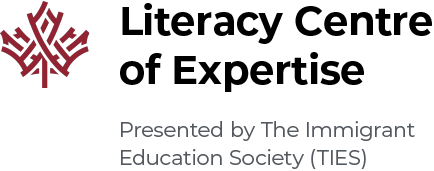
by Heather Imorde
Heather Imorde has recently joined TIES as a LINC Literacy Instructor. She has a passion for literacy and language and has been working in this space since 2008.
I have recently come across the idea of “translanguaging.” At first glance I liked its notions of language inclusion in a broader, more culturally sustaining way. The more I learned, however, the more I could see that while it is inclusive in nature, translanguaging could also lend itself to more effective English and literacy instruction.
So, what is “translanguaging”?
Dr. Garcia breaks it down. The “ing” in translanguaging comes from the notion that language is what people “do”; it is the agency of communication and meaning making. The “trans” in translanguaging suggests that people who are multilingual do not have specific areas of the brain dedicated to each of their languages.
Listen to “Translanguaging and Multilingualism in Schools ft. Ofelia Garcia” on Spreaker.
Shifting Linguistic Landscapes Podcast (by the University of Calgary): Listen to Dr. Ofelia García speak about translanguaging and multilingualism in schools.
This video discusses the benefits of approaching language instruction through a translanguaging lens.
These are definitely big ideas, and ones that offer a much broader approach to language development than I have previously used. I have generally approached reading and writing as cracking a language “code”. Cracking the code, for me, involved a discrete set of skills that when combined, resulted in a proficient reader and writer. I created my own scope and sequence that aligned with curriculum standards and slotted students into a linear progression of skills.
I am not saying that anything is wrong with this! It worked for me for a long time. What I am saying though, is that when I consider the unique needs of my current Foundation level learners, a broader approach may in fact be more suitable. English has a “code” to be sure, but how else can I leverage students’ semiotic resources and funds of knowledge they already possess?
Building a language toolbox
I am still learning in this space, but here are a few ideas I have tried to incorporate into my F/1L classroom in addition to focusing on phonemic awareness, phonological awareness and other skills that are, of course, still important for literacy learners:
Classroom ecology
- Allow students to use their first language (L1) to help explain or clarify concepts, tasks, assignments, instructions or activities. Students that share an L1 can collaborate, save classroom time, and build a positive co-created learning environment.
- Allow learners to brainstorm ideas for pre-tasks and allow them to use their cultural background to co-construct knowledge together.
- Greet students in their home languages and use multilingual greetings with all learners
Classroom instruction
- Where possible, use multi-language texts. For example, during our Winter Weather Module, we listened to this story from Storybooks Canada in Pashto and Arabic, and then read it in English.
- Google Translate and Google Read/Write
- Both tools are free, and while they do not have all languages, Google translate in particular has quite a few. I have used both to translate new vocabulary (orally, as the written translation would not work for these learners)
- Students can speak into Google translate and vice versa. When I was able to see them in person, I would show them how to use voice-to-text and other features to help them with real word tasks inside and outside the classroom.
Ultimately, my biggest takeaway from “translanguaging” is its natural invitation to approach language instruction from a strengths-based and student-focused perspective. As a pedagogical framework, it reminds me that my students, even with their limited English proficiency, know a lot and can communicate their understanding to me, when provided with opportunities to do so.
Ideas from:
Cummins, J. (2007). Rethinking monolingual instructional strategies in multilingual classrooms. Canadian Journal of Applied Linguistics, 10(2), 221–240.
García, O., & Wei, L. (2018). Translanguaging: Language, bilingualism and education. Basingstoke: Palgrave Macmillan.
Zulfikar, Z. (2019). Rethinking the Use Of L1 in L2 Classroom. Englisia Journal, 6(1), 42-51.

